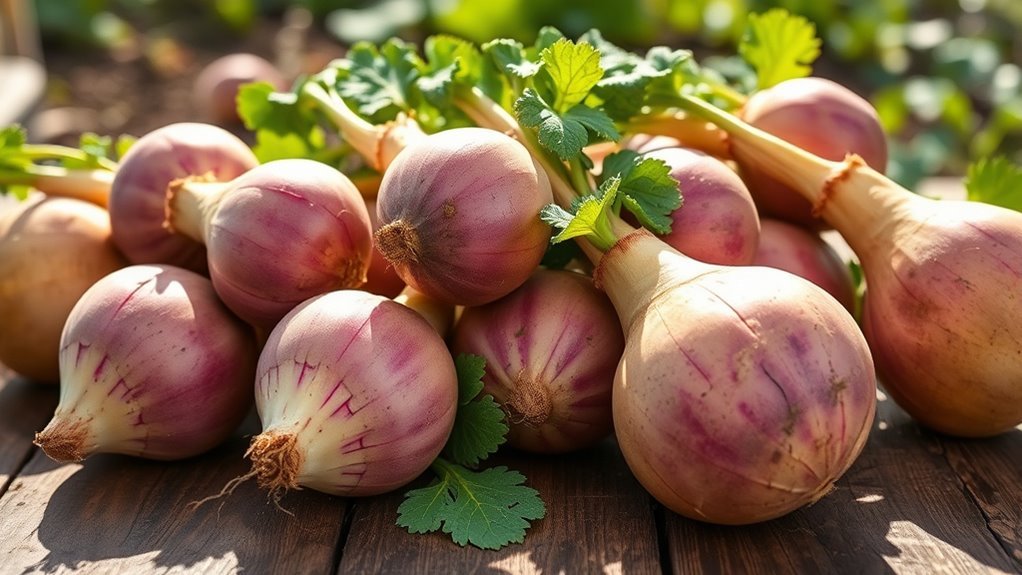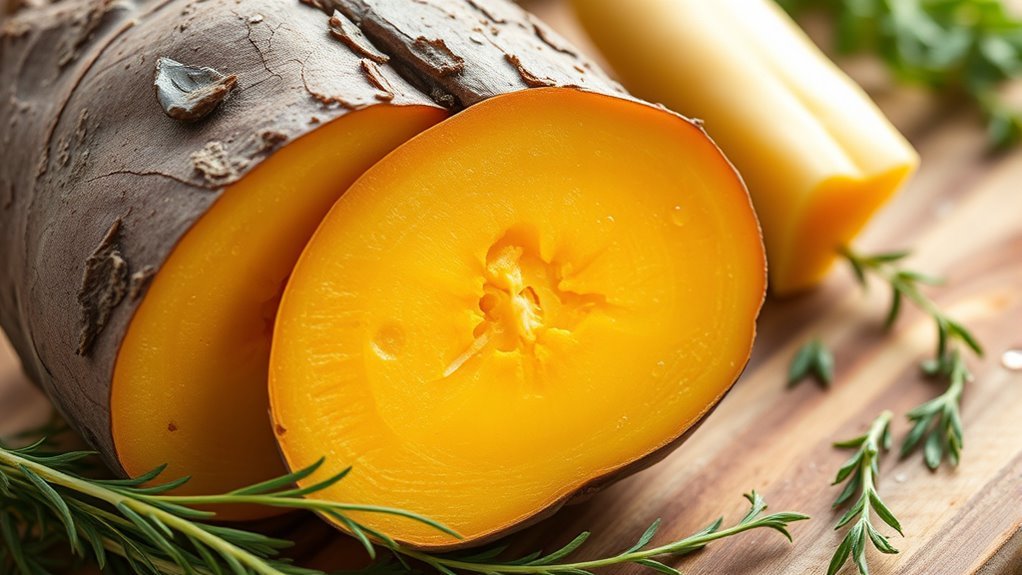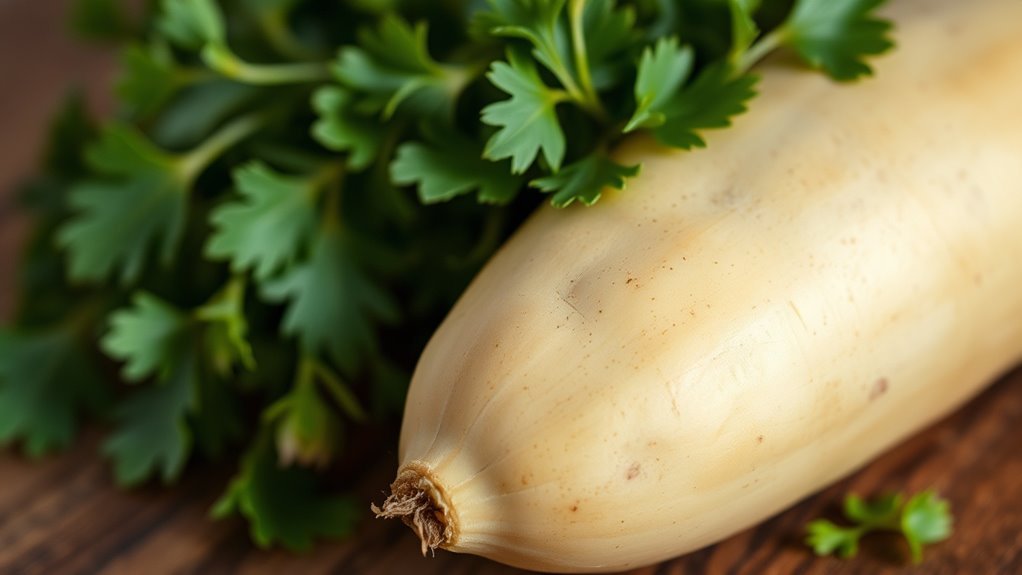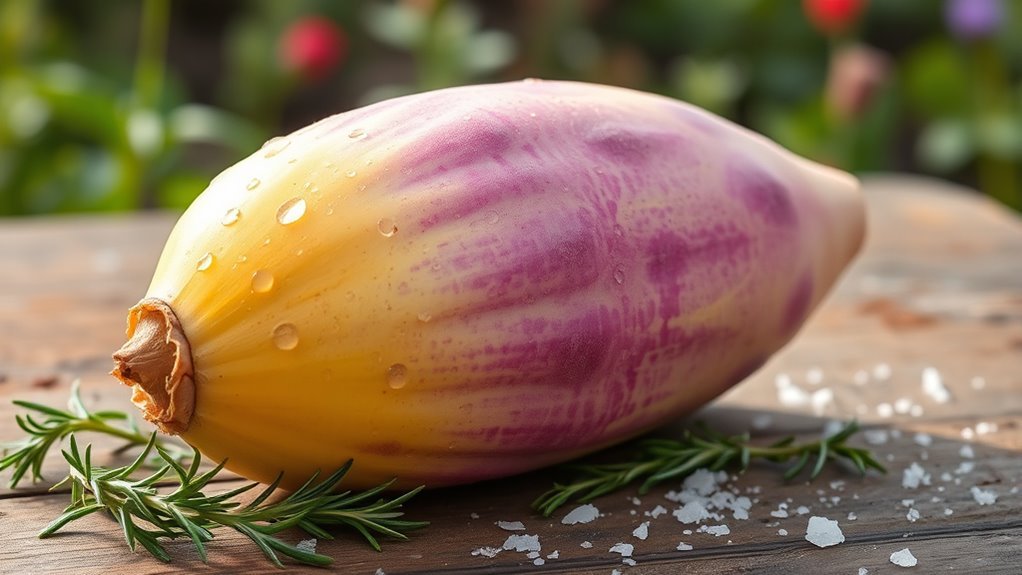Rutabaga can be keto-friendly, offering about 8 grams of net carbs per 100 grams. This makes it a moderate choice for those on a low-carb diet. While it’s versatile and nutritious, it’s important to manage portion sizes to stay within carb limits. Additionally, its high fiber content may lead to digestive discomfort for some. If you’re curious about how to incorporate rutabaga into your meals or its health benefits, you’ll find plenty of useful tips ahead.
Understanding Rutabaga: What Is It?

Rutabaga, often overlooked in the vegetable aisle, is a root vegetable that belongs to the brassica family, which also includes cabbage and kale. Its origins trace back to Scandinavia, where it was cultivated in the 18th century as a cross between a cabbage and a turnip. You’ll find various rutabaga varieties today, each with unique flavors and textures, ranging from yellow-fleshed to purple-skinned types. These options allow for diverse culinary uses, whether in soups, stews, or roasted dishes. Understanding the history and different types of rutabaga not only enriches your appreciation for this vegetable but also empowers your cooking choices. By exploring its roots and varieties, you can embrace this nutritious option in your meals with confidence.
Nutritional Profile of Rutabaga

When you take a closer look at the nutritional profile of rutabaga, you’ll find it’s a surprisingly healthy addition to your diet. This root vegetable is packed with essential nutrients and low in calories, making it an excellent choice for a variety of rutabaga recipes.
- Rich in vitamin C, which supports your immune system
- High in fiber, promoting digestive health
- Contains antioxidants that may reduce inflammation
There are several rutabaga varieties available, each offering unique flavors and textures. Incorporating rutabaga into your meals can help diversify your diet while providing crucial nutrients. Whether you’re roasting, mashing, or adding it to soups, rutabaga is a versatile ingredient that can enhance your overall health while satisfying your taste buds.
Carb Content: Is Rutabaga Keto-Friendly?

Wondering if rutabaga fits into a keto diet? Let’s break down its carb content. Rutabaga has about 8 grams of net carbs per 100 grams, making it a moderate choice for keto enthusiasts. Here’s a quick comparison:
| Food Item | Net Carbs (per 100g) | Keto-Friendly? |
|---|---|---|
| Rutabaga | 8g | Yes |
| Cauliflower | 3g | Yes |
| Zucchini | 3g | Yes |
| Sweet Potato | 20g | No |
If you’re looking for keto substitutions, rutabaga can replace higher-carb vegetables in your favorite rutabaga recipes. Enjoy its versatility while keeping your carb intake in check!
Health Benefits of Rutabaga
Rutabagas are packed with essential nutrients, making them a valuable addition to your diet. Their antioxidant properties can help combat oxidative stress, while their high fiber content supports digestive health. Incorporating rutabaga into your meals not only enhances flavor but also boosts your overall wellbeing.
Nutrient-Rich Profile
Although often overlooked, rutabaga offers a nutrient-rich profile that can benefit your health in various ways. Its impressive nutrient density makes it a great addition to your diet, especially if you’re looking to enhance your overall well-being. Here are some key rutabaga benefits:
- High in Vitamins: Packed with vitamin C and B6, supporting immunity and energy production.
- Rich in Fiber: Aids digestion and promotes a feeling of fullness, which can help with weight management.
- Low in Calories: A perfect choice for those seeking to enjoy vegetables without high calorie counts.
Incorporating rutabaga into your meals can provide essential nutrients while keeping your carb intake in check, making it ideal for keto enthusiasts. Embrace its versatility and reap the benefits!
Antioxidant Properties
While many vegetables are celebrated for their health benefits, rutabaga stands out due to its notable antioxidant properties. Packed with powerful rutabaga compounds, this root vegetable can help combat oxidative stress in your body. These antioxidants, including vitamin C and various phytochemicals, play a significant role in neutralizing free radicals, which are linked to chronic diseases. Incorporating rutabaga into your diet may enhance your overall health by providing these antioxidant benefits. Whether roasted, mashed, or added to soups, it’s a versatile veggie that not only adds flavor but can also contribute to your wellness journey. So, if you’re seeking a nutritious option, rutabaga may be a fantastic addition to your meals.
Digestive Health Benefits
When you include rutabaga in your diet, you’re not just enjoying a tasty vegetable; you’re also supporting your digestive health. Rutabaga is packed with fiber, which plays a vital role in maintaining a healthy gut microbiome. By promoting the growth of beneficial bacteria, it helps improve digestion and nutrient absorption.
- Supports the production of digestive enzymes
- Enhances gut health and regularity
- May reduce bloating and discomfort
Incorporating rutabaga can lead to a more balanced digestive system. The fiber content aids in preventing constipation, while its prebiotic properties nourish the good bacteria in your gut. So, if you’re looking for a delicious way to boost your digestive wellness, rutabaga is a fantastic choice!
Comparing Rutabaga to Other Low-Carb Vegetables
Rutabaga stands out among low-carb vegetables, but how does it really compare to its counterparts? When you look at rutabaga benefits, you’ll find it’s a great source of fiber and vitamins, making it a healthy addition to your keto diet. Compared to alternatives like cauliflower or zucchini, rutabaga has slightly higher carbs but packs more nutrients. Cauliflower is often favored for its lower carb count, while zucchini offers a revitalizing, low-calorie option. However, rutabaga’s unique flavor and versatility can make it a satisfying choice. Ultimately, if you’re seeking variety in your low-carb meals, consider incorporating rutabaga alongside other vegetables to enjoy a broader spectrum of nutrients while still keeping carbs in check.
How to Prepare and Cook Rutabaga
When it comes to preparing rutabaga, knowing how to cut and peel it can make a big difference in your cooking process. You can choose various methods to cook it, such as roasting, boiling, or mashing, depending on your meal preference. Understanding these basics will help you enjoy this nutritious vegetable in your keto-friendly dishes.
Cutting and Peeling Tips
Although preparing rutabaga may seem overwhelming at first, mastering the cutting and peeling process can greatly enhance your cooking experience. Here are some effective tips to simplify the task:
- Use a sharp peeler for smooth peeling methods.
- Cut off the ends and slice it in half for better stability while cutting.
- Employ various cutting techniques, like julienne or cubes, to suit your recipe.
Start by peeling away the tough outer skin, then proceed to cut the rutabaga into manageable pieces. Remember, consistent sizing helps guarantee even cooking. Don’t be afraid to experiment with different shapes and sizes; it can add a unique flair to your dishes. With practice, you’ll find these techniques will become second nature. Enjoy the freedom of cooking!
Cooking Methods Overview
Cooking rutabaga offers a variety of methods that can highlight its unique flavor and texture. You can choose from boiling, roasting, or mashing to suit your taste. Each method showcases different rutabaga textures—creamy when mashed, caramelized when roasted, and tender when boiled. Here’s a quick overview:
| Cooking Method | Description |
|---|---|
| Boiling | Softens rutabaga quickly; great for mashing. |
| Roasting | Enhances sweetness and texture; perfect for sides. |
| Mashing | Combines rutabaga with butter or cream for a rich dish. |
Explore different rutabaga recipes to find your favorite. Each cooking method can transform this versatile vegetable into a delicious addition to your meals, keeping your keto diet exciting!
Creative Ways to Incorporate Rutabaga Into Your Meals
While rutabaga might not be the first vegetable that comes to mind for your keto meals, its versatility can surprise you. You can easily incorporate rutabaga into your diet with these creative ideas:
- Rutabaga fries: Cut them into sticks, season, and bake for a crunchy snack.
- Rutabaga mash: Boil and mash them with butter for a creamy side dish.
- Rutabaga salads: Grate raw rutabaga into salads for a crunchy texture.
Explore rutabaga recipes like soups, casseroles, and gratins to keep your meals exciting. You can even blend rutabaga into smoothies for a nutrient boost! With these options, you can enjoy delicious rutabaga snacks while staying on track with your keto lifestyle.
Potential Drawbacks of Eating Rutabaga on Keto
Rutabaga can certainly add variety to your keto meals, but it’s important to contemplate some potential drawbacks of including this root vegetable in your diet. For one, rutabaga contains more carbs than other low-carb vegetables, which could pose keto diet challenges if you’re not careful about portion sizes. A medium rutabaga has around 8 grams of net carbs, so it’s easy to exceed your daily limits. Additionally, some people may experience digestive issues due to its high fiber content, leading to discomfort. It’s essential to balance your meals and monitor how your body responds. While rutabaga offers nutritional benefits, understanding these potential rutabaga drawbacks can help you make informed choices on your keto journey.
Final Thoughts on Rutabaga and a Keto Diet
Although incorporating rutabaga into your keto diet can introduce new flavors and textures, it is crucial to weigh the benefits against the carbohydrate content. Here are some health considerations to keep in mind:
- Rutabaga is lower in carbs than many starchy vegetables, but still contains some carbs.
- It’s a good source of fiber, aiding digestion and potentially keeping you fuller longer.
- Exploring keto alternatives, like cauliflower, can help you stay within your carb limits.
Ultimately, if you enjoy rutabaga, it can be included in moderation. Just remember to monitor your overall carb intake and listen to your body. Balancing enjoyment with nutritional goals is key to a sustainable keto journey, allowing you the freedom to explore new ingredients responsibly.
Frequently Asked Questions
Can I Eat Rutabaga Raw on a Keto Diet?
You can definitely eat raw rutabaga on a keto diet. It’s a nutritious choice packed with vitamins and minerals. The raw rutabaga benefits include being low in carbs and high in fiber, making it a great option among keto vegetable choices. Plus, its crunchy texture adds variety to your meals. Just remember to keep an eye on your overall carb intake, but incorporating raw rutabaga can be a delicious, healthy addition!
How Does Rutabaga Affect Ketosis?
How does rutabaga fit into your ketosis journey? While rutabaga offers nutrition like fiber and vitamins, its carb content can impact your state of ketosis. If you’re aiming for ketosis benefits, it’s essential to monitor your intake. A small serving might be okay, but too much could lead you out of that metabolic state. Balance is key, so consider rutabaga as a rare treat rather than a staple in your keto diet.
Is Rutabaga Suitable for a Low-Carb Vegetarian Diet?
Yes, rutabaga is suitable for a low-carb vegetarian diet. It offers a variety of nutritional benefits, including fiber, vitamins, and minerals, making it a wholesome choice. You can incorporate rutabaga into various vegetarian recipes, from soups to casseroles. Its slightly sweet flavor adds depth to dishes while keeping carb counts low. So, if you’re looking for a versatile veggie that aligns with your dietary goals, rutabaga’s definitely worth considering!
What Is the Best Way to Store Rutabaga?
To store rutabaga effectively, keep it in a cool, dark place, like a root cellar or a pantry. Make sure it’s unwashed, as moisture can promote rot. If you’ve cut it, wrap the pieces tightly in plastic wrap and refrigerate them. For longer-term preservation, consider freezing after blanching. These storing tips can help you enjoy fresh rutabaga for weeks, maintaining its flavor and nutritional value while minimizing waste.
Are There Any Keto Alternatives to Rutabaga?
Finding keto alternatives to rutabaga is like steering through a culinary treasure map. You’ve got several low carb options to reflect on. Turnips, for instance, are a great substitute, offering a similar texture and flavor profile. Cauliflower, with its versatility, can also be transformed into rice or mash. Zucchini noodles are another fantastic choice for those seeking keto substitutes that keep meals exciting without compromising your dietary goals. Explore these options to maintain your freedom on a keto journey!


